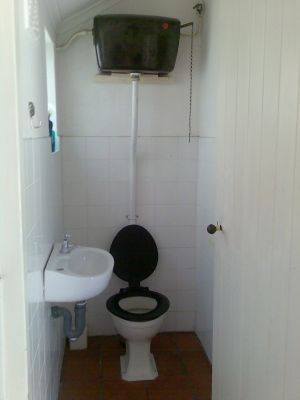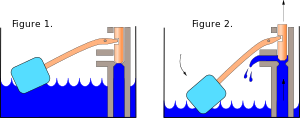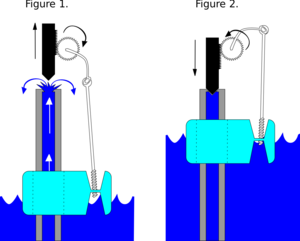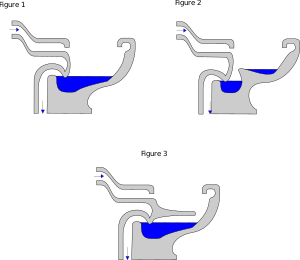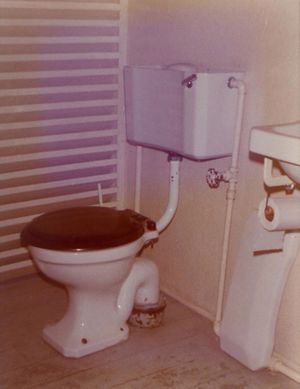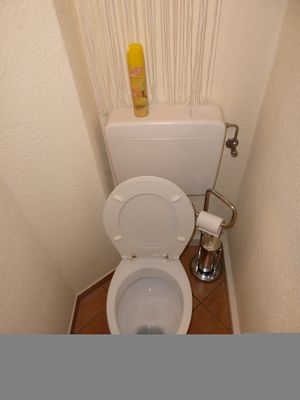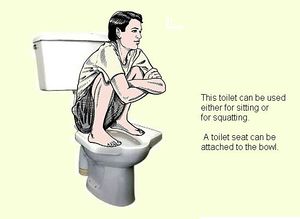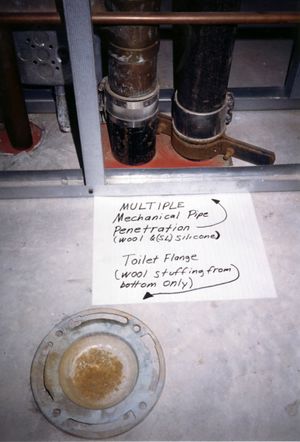مرحاض بسيفون
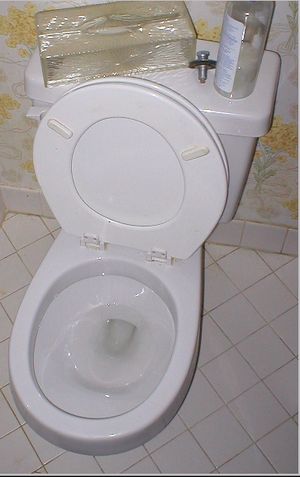
مرحاض بسيفون flush toilet، هو مرحاض يصرف الفضلات البشرية باستخدام مياه السيفون الموجود في مكان مجاور. توجد السيفونات عادة في المراحيض الغربية (تستخدم في وضعية الجلوس)، لكنها تتوافر أيضاً في المراحيض العربية حيث يتم صرف الفضلات عن طريق سيفون معلق على الحائط.[1] يصمم مرحاض السيفون على شكل الحروف "S"، "U"، "J"، أو "P" بهدف تجميع الفضلات والغازات المنبعثة منها وتسهيل تصريفها. يتصل المرحاض بأنابيب صرف مثبتة في خليفته تتصل بأنابيب صرف خارجية، المتصلة بأنظمة معالجة الصرف الصحي.
التاريخ
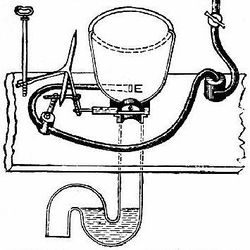
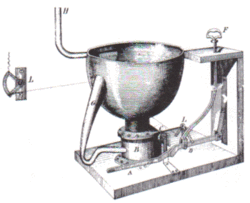
مثل العديد من الاختراعات، كانت مرحاض السيفون نتيجة لسلسلة من التطويرات.
- ح. القرن 31 ق.م: أقدم قرية من العصر الحجري الحديث في بريطانيا، سكارا براي، اوركني، استخدمت تكنولوجيا هيدروليكية حجرية نيوليثية.[4] وقد استخدم تصميم القرية نهراً ونظام صرف متصل به للتخلص من الفضلات.
- ح. القرن 26 ق.م: المراحيض ذات السيفون اُستُخدمت لأول مرة في حضارة وادي السند. مدن هراپا وموهنجو-دارو had a flush toilet in almost every house, attached to a sophisticated sewage system.[5] See also الهندسة الهيدروليكية في حضارة وادي السند.
- ح. القرن 18 ق.م: Flush toilet constructed at كنوسوس on Minoan كريت[6]
- circa 15th century BC: Flush toilets used in the Minoan city of أكروتيري.[بحاجة لمصدر]
- 9th century BC: Flush toilets on Bahrain Island.[7]
- من القرن 1 ق.م - قرن 5: Flush toilets were used throughout the الامبراطورية الرومانية. Some examples include those at Vindolanda on جدار هادريان في بريطانيا. With the fall of the Roman Empire, the technology was lost in the West.[بحاجة لمصدر]
- 1206: اخترع المخترع العربي الجزري جهازاً لغسل الأيدي يتضمن آلية سيفون، تستخدم حتى يومنا هذا في المراحيض ذات السيفون. His device features a mechanism for filling the basin with water. When the user pulls the lever, the water drains and the mechanism refills the basin.[8][المصدر لا يؤكد ذلك]
- 1596: نشر السير جون هارنگتون (1561–1612) A New Discourse of a Stale Subject, Called the Metamorphosis of Ajax, describing a forerunner to the modern flush toilet installed at his house at Kelston.[9] The design had a flush valve to let water out of the tank, and a wash-down design to empty the bowl. وقد ركـَّب واحداً لجدته الملكة إليزابث الأولى في قصر ريتشموند، بالرغم من أنها رفضت استخدامه لأنه يُحدث جلبة صاخبة.[بحاجة لمصدر] The Ajax was not taken up on a wide scale in إنگلترة, but was adopted in فرنسا تحت اسم Angrez.
- 1738: A valve-type flush toilet was invented by J. F. Brondel.
- 1775: ألكسندر كمنگز اخترع مصيدة حرف إس (براءة اختراع رقم 814?)، التي لا زالت تستخدم حتى اليوم، تقوم بنقل المياه الراكدة إلى قاعدة المرحاض، ومنع تسرب الغازات الكريهة خارج المصرف. His design had a sliding valve in the bowl outlet above the trap.
- 1777: اخترع صمويل پروسر وحصل على براءة 'دورة سدادة plunger closet'.
- 1778: اخترع جوسف براماه صمام مفصلي أو 'صمام كرداني' يغلق قاع السلطانية، ونظام صمام طافي لخزان السيفون. وقد أُستُخدم تصميمه أساساً في المراكب.
- 1851: The first popularized water closets were exhibited at القصر البلوري and these became the first public toilets. They had attendants dressed in white and customers were charged a penny for use. This is supposedly the origin of the phrase "To spend a penny" which did not appear in print until the 1940s.
- 1852: George Jennings invented a wash-out design with a shallow pan emptying into an S-trap.
- 1857: The first American patent for a toilet, the 'plunger closet', was granted.
- 1858: The first flush toilets on the European continent may have been the three "waterclosets" installed in the new town house of banker Nicolay August Andresen on 6 Kirkegaten in Christiania, insured in January 1859. The toilets were probably imported from England, as they were referred to by the English term "waterclosets" in the insurance ledger.
- 1860: دورة مياة مبكرة أخرى في القارة الاوروبية كان قد تم استيرادها من إنگلترة. وقد تم تركيبها في غرف الملكة ڤيكتوريا في قصر إرنبورگ (كوبورگ، ألمانيا)؛ وكانت الوحيدة المسموح لها باستخدامه.
- ع 1880: Thomas Crapper's plumbing company built flush toilets of Giblin's design. Although not the original inventor, Crapper popularized the siphon system for emptying the tank, replacing the earlier floating valve system which was prone to leaks. Some of Crapper's designs were made by Thomas Twyford. The similarity between Crapper's name and the much older word crap is a coincidence.
- 1885: The first modern pedestal 'flush-down' toilet was demonstrated by Frederick Humpherson of the Beaufort Works, Chelsea, إنگلترة.[10]
- 1885: Thomas Twyford built the first one-piece ceramic toilet using the flush-out siphon design by J. G. Jennings.
- 1898: Albert Giblin received British patent 4990 for the "Silent Valveless Water Waste Preventer", a siphon discharge system.[بحاجة لمصدر][11]
- 1906: William Elvis Sloan invented the Flushometer, which used pressurized water directly from the supply line for faster recycle time between flushes. The Flushometer is still in use today in public restrooms worldwide.
- 1907: Thomas MacAvity Stewart of Saint John, New Brunswick patented the vortex-flushing toilet bowl, which creates a self cleansing effect.[12]
- 1980: Bruce Thompson, working for Caroma in أستراليا, developed the Duoset cistern with two buttons and two flush volumes as a water-saving measure. Modern versions of the Duoset are now available worldwide, and save the average household 67% of their normal water usage.[13]
آلية العمل
يعمل السيفون على تدفق كمية كبيرة من المياه في المرحاض. وتتدفق المياه على جانب أو أكثر في أسفل قاعدة المرحاض.
صمام ملئ خزان المياه
خزان بلصمام عائم
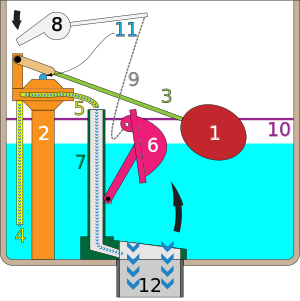
1. float, 2. fill valve, 3. lift arm, 4. tank fill tube, 5. bowl fill tube, 6. flush valve flapper, 7. overflow tube, 8. flush handle, 9. chain, 10. fill line, 11. fill valve shaft, 12. flush tube
خزان بسيفون
خزان بصمام ضغط عالي أو مساعد
بدون خزان وبصمام ضغط عالي (مقياس تدفع)
صمام الدلو
تصميم سلطانية المرحاض
مرحاض بسيفون
مرحاض بدون سيفون
الصمام المغلق
مرحاض ألماني
هو مرحاض يستخدم بصفة خاصة في ألمانيا والنمسا، ويوجد به رف داخلي للاحتفاظ بالفضلات لفحصها طبياً قبل التخلص منها.
الوعاء العكسي
اختلافات ثقافية
في الهند يوجد مرحاض تم تصميمه ليستخدم للتبول في وضع الجلوس أو الوقوف.
مرحاض بسيفون منخفض
المقاييس الأمريكية للمراحيض الحديثة
متنوعات
انظر أيضاً
المصادر
- ^ "Flushing squat toilets", naturesplatform.com
- ^ "The Men That Made the Water Closet". theplumber.com.
- ^ "Friday Photo: 18th Century Technology". Hammond-Harwood House.
- ^ Virginia Sarah Smith (2007), Clean: a history of personal hygiene and purity, p. 28, ISBN 978-0-19-929779-5, http://books.google.com/?id=GZBsRv17U3gC&printsec=frontcover&dq=Clean:+a+history+of+personal+hygiene+and+purity#v=onepage&q=Skara%20Brae%20drop%20toilet&f=false, retrieved on 30 July 2010
- ^ Rodda, J. C. and Ubertini, Lucio (2004). The Basis of Civilization - Water Science? pg 161. International Association of Hydrological Sciences (International Association of Hydrological Sciences Press 2004).
- ^ C. Michael Hogan. 2007. Knossos fieldnotes, The Modern Antiquarian
- ^ "Sulabh International Museum of Toilets". Sulabhtoiletmuseum.org. Retrieved 2011-11-18.
- ^ Rosheim, Mark E. (1994), Robot Evolution: The Development of Anthrobotics, Wiley-IEEE, pp. 9–10, ISBN 0-471-02622-0
- ^ Kinghorn, Jonathan (1986), "A Privvie in Perfection: Sir John Harrington's Water Closet", Bath History 1: 173–188. ISBN 0-86299-294-X. Kinghorn supervised a modern reconstruction in 1981, based on the illustrated description by Harington's assistant Thomas Coombe in the New Discourse.
- ^ Eveleigh, David J. (2008), Privies and Water Closets, Oxford: Shire Publications, ISBN 978-0-7478-0702-5
- ^ Giblin, Albert, "Improvements in Flushing Cisterns", GB 189804990
- ^ Mario Theriault, Great Maritime Inventions 1833-1950, Goose Lane Editions, 2001, p. 34.
- ^ "100 Years of Australian Innovation - Dual flush technology". Biotechnology-innovation.com.au. 2007-04-18. Retrieved 2011-11-18.
وصلات خارجية
- Intelligent Bathroom Fixtures and Systems (comparison between passive and active vision systems for use with plumbing fixtures, as published in Leonardo, 36(3), pp 199–120, June 2003)
- A Brief history of Wells and Toilets, 2005 book (link to pdf-file)
- Did Thomas Crapper invent the flush toilet? - at Snopes
- "Superflushing their way to the Super Bowl" - PM Engineer
